HartleyT.S. 16
by Dennis L. Angelisanti
Photographs by Robert Hagan
Small Boat Journal #35 March 1984
In the land down-under, where the passion for
sailing fast is legend, the Hartley Trailer/Sailer 16 is the
largest and most active trailer/sailer class among an abundance
of T.S. classes. What makes this 20-plus year-old class of largely
home-built plywood sailboats so popular? The reasons are manifold.
At the same overall length and weighing only 250 pounds more
than the famous Wayfarer dinghy, the Hartley offers a large
cabin for two adults to camp cruise without scrimping on cockpit
space. In light airs, she can outsail the
Daysailer II, and in heavy air, her planing hull will let her
slip bv the Catalina 22. This is the Hartley's strong suit,
a trailerable family boat for cruising and picnicking that can
provide fast and furious action for racing crews — all
for a built-it-yourself price of less than $3,000!
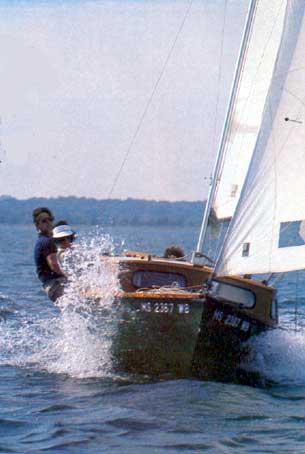
Spray flying, a Hartley
16 sails along smartly on a fast reach.
The Hartley T.S. 16 is not likely to inspire
"love-at-first-sight." It is rather "plain vanilla,"
a butter dish in style with chunky sections, short ends, and
double-chined hull. But in the fall of 1978, I chose to build
her anyway because she was cheap, trailerable, roomy in the
cockpit, and spacious enough in the cabin for two adults to
cruise in relative comfort. That decision commenced a relationship
with a boat, a designer, and the enthusiastic sailors of a class
association that, I hope, will endure through the years.
In the 1950s, New Zealander Richard Hartley designed
an unusual-looking combination of centerboard dinghy and half
cabin yacht based on the lines of the famous New Zealand mullet
boats. Mullets were beamy fishing boats that sailed well and
were often raced. When Hartley saw the possibility of adapting
mullet boat principles to a smaller, family boat, the wide-beamed,
performance-oriented Hartley line of trailer sailers was born.
Meanwhile, in Australia, a boat-building boom
was in progress, and when amateurs wanted to build something
in plywood that was bigger than a dinghy, they turned to the
Hartley T.S. 16. Many nine-to-fivers built one in their garages,
beginning a movement that soon created a new class boat. For
a cost not much more than a good sailing dinghy, and certainly
a lot less than a fiberglass cabin yacht, the T.S. 16 allowed
the whole family to sail together. Indeed, by 1972, eight years
after the founding of the class association, so many families
had recognized the virtues of the T.S. 16 that 585 boats were
on the
association register. The growth of the class declined in the
late seventies as the advent of fiberglass, factory-produced
trailer-sailers and the increasing affluence of Australians
made people less inclined to build. However, the Hartley was
a little like the old VW Bug in the way she won people's affection.
She wasn't pretty, but there were so
many around that first time sailing families could buy one cheaply
and have a ball learning to sail. The Hartley had a lot going
for it that had been overlooked in the rush towards bigger and
better, and as so often happens with new ideas, the original
concept proved hard to beat. By 1982, the Australian Hartley
T.S. 16 Association recorded 1,289 boats in its register, an
increase of 120 percent in ten years. An exact figure for the
class is hard to come by
since many boats remain unregistered. Worldwide sales of plans
approach 6,000,and association members report boats in New Guinea,
Fiji, England, the United States, Canada,
and of course, New Zealand.

A Racing Trailer/Sailer
from the lands down-under

The T.S. 16 is raced with a crew of two, and although
it doesn't carry a spinnaker, the little cruiser attracts some
of Australia's best small-boat skippers. So much sail area (180
square feet] on such a lightweight craft 1800 pounds displacement)
means that it is very fast and exciting sailing, especially
in fresh breezes. Race-tuned Hartley 16s are mighty hard to
beat, even with larger boats. In Australia, their planing ability
allows them to race against boats that are 30 percent longer.
Bill Culverwell, a successful T.S. 16 skipper in New South Wales,
explains:
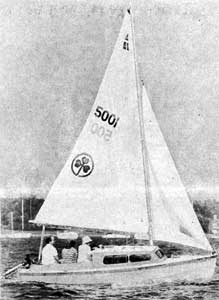
Hartley 16s have dual
personalties, either as comfortable family cruisers (above)
or competitive racers (below)
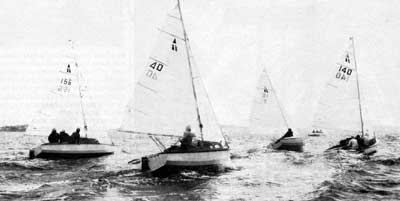
Planing is not this boat's only claim to fame.
In light airs, she can ghost along with the best of them, and
in drifting conditions, she can pass boats with yards of lightweight
headsails, driving their owners to drink. In light to moderate
breezes, she sails best with fuller than average sails and with
the jib backwinding the main. As the wind picks up, she lays
over easily and then hangs there, rock steady, until the wind
exceeds 18 knots. At this wind speed, it is wise to swing crew
weight outboard, keeping her lee rail about six inches from
the water. This is her best sailing angle. The Hartley, like
most wide-beamed boats, does not crash through the swells, but
rather rides over them like a cork. However, in a steep chop,
she can pound somewhat. A skeg keel and long boom combine to
give responsive
but not twitchy handling characteristics.
For cruising or less intense racing, the boat
easily handles four adults in it's roomy cockpit. On more than
one occasion, our T.S. 16 has sailed with six aboard, although
it is a tad close. With three or four in the cockpit, or when
loaded for cruising with two, she sails with a light stern squat
and a very neutral helm. Loaded this way, she is not a racer,
but a stable, predictable family-oriented cruiser. For racing,
crew weight, as well as all gear, is kept well forward in the
cockpit or cabin, helping get the wide stern out of the water.
The helm is neutral for the most part, or in lighter airs slightly
lee. As wind speed increases or as she comes off the wind, the
weather helm becomes noticeable, but never extreme. As might
be expected of such a race oriented class, Hartley owners have
found a number of ways to extract the greatest amount of speed
from the wind. The 125-square-foot mainsail is set on a non-bendy
rig where it packs a real punch, and race-hardened T.S. 16 sailers
know how to work this powerful mainsail to get past newer designs
with reduced versions of big yacht rigs.
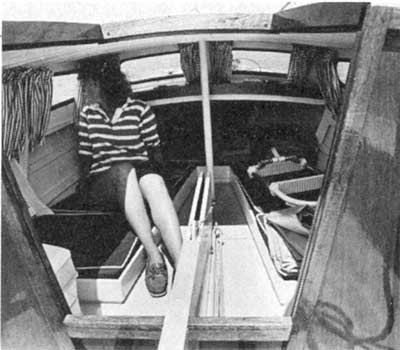
Simplicity is the key
to Hartley's trailer/sailer. Down below, the 16 features low
bunks for sitting headroom and lots of windows for enjoying
the view
The main can be reefed, and in winds above 20
knots, this is recommended. In addition, most owners install
jib furling for smoother sail handling while cruising. A maximum
of five mainsail battens are allowed, including two full or
through battens at the head. Four small battens are allowed
on the headsail. For controlling sail shape, the class association
permits a mainsheet traveller, a cunningham eye on the main,
a foot outhaul, powerful vangs, adjustable jib luff wire, and
barber hauls.
A vang is absolutely essential to control the
shape of the big main. By keeping the main's leech tight when
the mainsheet is eased to spill off excess wind, the vang prevents
the mainsail from flogging like a flag, increasing drag, and
inducing too much heel. The vang also pulls the boom into the
mast, stopping the mast from bending backward and eliminating
too full a sail when the wind pipes up. The forces in play also
spring the boom down about three inches, further flattening
the sail.
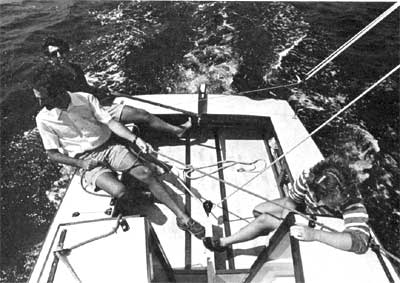
The flat decks and wide
cockpit help crew weight keep the boat upright.
In fresh breezes, one of the first things you
realize is that the main cannot be depowered by a bendy mast.
The straight aluminum section, its size strictly governed by
class rules, is stepped on the cabin top and is rigged with
fairly stiff diamond spreaders so it won't go over the side.
Because the mast does not bend, you sail her racing skiff style,
easing the main in gusts and hauling it in during the lulls.
Really heavy crews naturally love strong winds because they
can power sail along while the light crews struggle to keep
the boat on its feet.
Crewed heavy or light, T.S. 16s get a bad case
of the slows upwind if you do not work the mainsheet all the
time. A fit body and good speed to windward are the rewards
for all the hard work.
Downwind, the 55-square-foot headsail is poled
out at the clew and eased off at the tack, which is cunningly
sheeted a foot or so in from the bow, becoming a jury-rigged
spinnaker of sorts. The Hartley really scoots in this mode,
and in anything over 11 knots of wind, this point of sail makes
for an exciting sleigh ride as the boat surfs down the swells.
Although the Hartley T.S. 16 is not a development class, occasional
changes are made to the strict one-design rules. Fiberglass
hulls and decks became legal only recently, and only after the
rules committee studied the issue for several years and was
sure neither the wood nor glass versions would have a competitive
edge. A fiberglass version has yet to win the nationals, however.
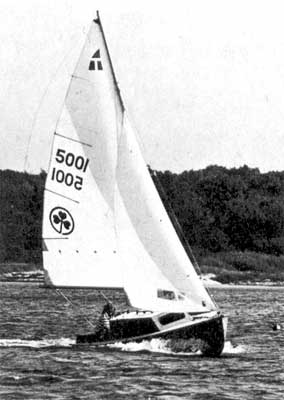
The Hartleys boxy shape,
designed for easy home building with plywood, disguises a slick
hull that sails fast
Even small changes, such as allowing aluminum
rudder cheeks, are debated at length, and only when compatibility
with original specifications is assured are changes approved.
The goal of the association is to prevent any Hartley from becoming
obsolete, and it is quite possible for early model boats built
in the sixties still to be very competitive.
The cockpit floor on a "16" is flat
and level with no obstructions, and the wide decks serve as
seats. A low coaming, its minimum height governed by class rules,
helps keep out water. These side decks have openings beneath
for storage and cruising gear. One need not step gingerly onto
a T.S. 16 because the broad beam allows one to stand outboard
on her side decks without heeling her significantly. The wide
side decks continue to the foredeck so one doesn't need to be
acrobatic to go forward for setting anchor or handling the headsail.
While the cockpit layout is determined by the individual builder,
all boats must have an outboard well and standard seat heights
and flooring. The wide decks/seats prevent water from filling
the cockpit in the unlikely event of a knockdown. With only
150 pounds of her displacement in her steel centerboard, the
T.S. 16 is not immune to capsize, but she has enough built-in
buoyancy to float, and she's small enough to be righted by the
crew.
Hartleys have two, six-foot three inch bunks
of substantial width, with full sitting headroom for anyone
under six feet tall. Again, the interior layout is up to each
builder. All boats must have two bunks, and the companionway
opening is restricted to a maximum width of thirty inches for
safety reasons. There is plenty of room below for a portable
head, although use of it requires someone with few inhibitions.
The six large windows cutting into the cabin sides make for
cheerful lighting. Windscreen windows are optional. In order
to expand accommodations, many owners install boom tents over
the six-foot-long, level cockpit sole, which allows for two
sleeping bags along with their contents.
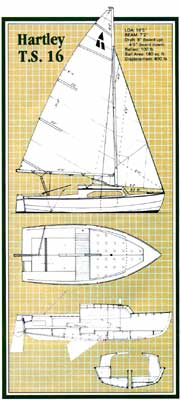 Once
the racing and cruising are over, one of the nicest aspects
of the Hartley 16 is how easily it can be trailered. The gear
is so light that one person can rig or unrig the boat. My Hartley
is set up so most control lines and rigging stay attached to
the boat, and my wife and I can rig and launch the boat in twenty
minutes.
Once
the racing and cruising are over, one of the nicest aspects
of the Hartley 16 is how easily it can be trailered. The gear
is so light that one person can rig or unrig the boat. My Hartley
is set up so most control lines and rigging stay attached to
the boat, and my wife and I can rig and launch the boat in twenty
minutes.
The only "disadvantage" of a Hartley
16 is that in order to own one you'll probably have to build
it. You can start your Hartley 16 for as little as $300, including
the cost of plans, full-size patterns, and a frame kit, and
have some money left for epoxy, screws, and lumber for the building
stock.
Mailmen, airline pilots, farmers, engineers,
and career bureaucrats have all built Hartleys. There is nothing
with which the average handyman, using only hand tools, a power
drill, circular saw, and jig saw, cannot cope. My boat was completed
in two years of strictly part-time work. A builder in New Jersey
completed his boat in one intensive building session over the
winter. Most boats can be completed in a period sometime between
these two extremes.
The T.S. 16 hull is built inverted by setting
up five sawn, built-up frames and a transom on a building stock.
Double chines and many bottom stringers insure a strong, stiff
hull. Quarter-inch, solid-core plywood sheathes the framework.
Although quarter-inch plywood may sound inadequate, the design
has withstood the test of time, and personal experience shows
that increasing the plywood thickness would be overbuilding.
Most owners do cover the hull in epoxy-saturated fiberglass
cloth to protect the plywood when beaching the boat.
After completing the hull, have a picnic and
invite some strong-backed friends to turn it over. Finishing
the cockpit, decks, and cabin are straight forward and can be
accomplished on a trailer or on a garage floor, using old tires
to support the hull. A steel centerboard which weighs approximately
150 pounds may cause some stressful moments, both in finding
a shop to fabricate it and maneuvering it into its slot in the
case.
All other construction, including rigging, is
relatively easy. When she slides off the trailer and settles
onto the water, you'll probably forget any bad moments right
away.
Although some 90-odd classes of trailer/sailers
exist in Australia, the wooden T.S. 16 is still the most popular,
with new constructions starting by the dozen. T.S. 16 owners
have the backing of the largest class association in Australia
with divisions in all states. All have full programs of racing
and cruising events, social outings, and assistance to new builders.
Monthly newsletters help keep the membership "in touch"
and share "trade secrets" that increase competition
among fleets. Cruising activities and family outings are announced
and reported, sharing the spotlight equally with racing news.
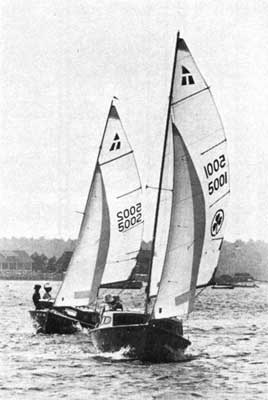
When two Hartleys meet,
a race is inevitable.
Each state runs an annual state championship,
and representatives from all states and New Zealand compete
in the Nationals each year. Probably the biggest endorsement
for this design as a racer/cruiser is its fine showing each
year at an event called the Marley Point overnight race. Australians
describe it as "Marley Madness", because of the more
than 500 boats that race across the Gippsland Lakes in Victoria,
a distance of nearly 35 miles. Boats must be at least five meters
in length and have overnight accommodations. The Hartley T.S.
16 is the smallest competitor. More than 90 enthusiastic association
members showed up in 1981; 68 crossed the finish line. Overall,
the Hartley does very well in the standings and even without
a handicap, finishes ahead of many larger yachts.
The Hartley T.S. 16 is now looking for its sea
legs in the United States. Sail numbers 5001 through 6000 have
been reserved for a fledgling American fleet, and 12 boats have
registered so far. In view of today's costly fiberglass boats,
the Hartley may be the easiest way for a family to begin cruising
local waters. And when one Hartley owner spots another, can
they resist a race? Thousands of Australians can't.

Plans and information on the Hartley Trailer/Sailer
16 are available through the Hartley T.S. 16 American Association,
10 Pinewood Dr., Douglasville, PA 19518. Clark Craft Boat Company,
l6-B Aqualane,Tonawanda, NY 14150, (Phone: (713) 873-2640),
also handles plans and frame sets, in addition to sails, fittings,
spars ana rigging kits, and screw and nail kits.


